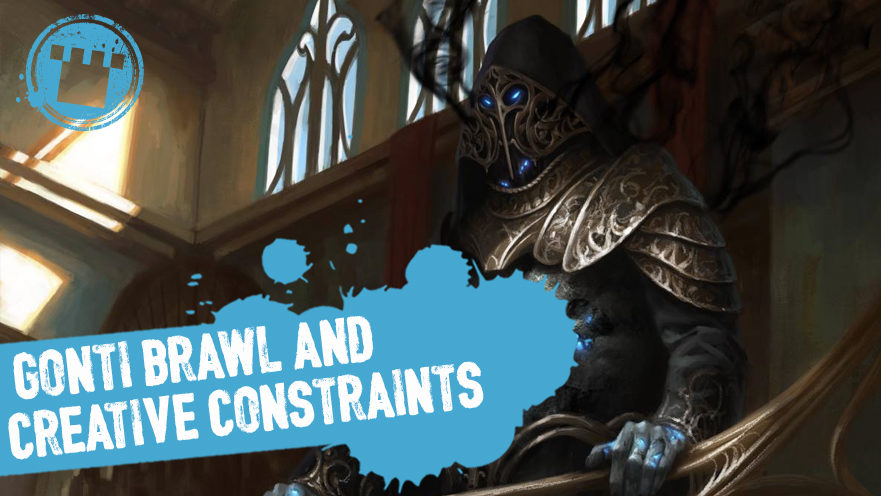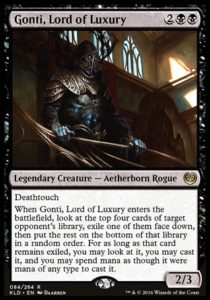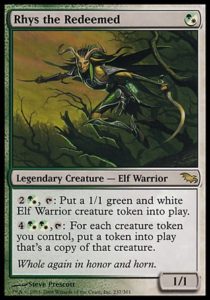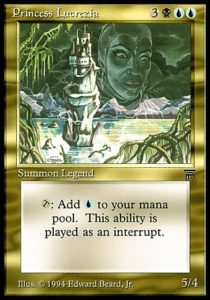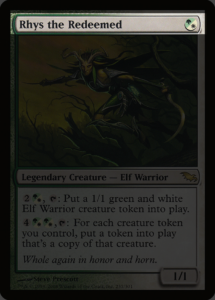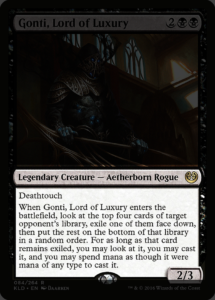So, you lost another game of Magic. (Cue Captain America meme.) It wasn’t one of those Archenemy Planechase Two-Headed Giant Commander extravaganza games worthy of future-told tales. And you made some sloppy decisions during that game. Yet you’re grinning from ear to ear. What gives?
What happened was that your deck got to do “its thing” in a game. Another player noticed that neato thing for the first time and commented warmly on it! Your deck’s shtick didn’t help you win the game, but this kind of moment is part of why you’re a Magic player, you Jenny/Johnny, you!
Not sure what the player psychographics are? You can read more about them in Mark Rosewater’s article here.
Restrictions Breed Creativity
Most Magic formats provide opportunities for Jennies and Johnnies to express themselves, whether it’s with an original combo or with some weird deck theme. While Standard and Modern provide some room for self-expression, the non-sanctioned casual singleton formats of Commander and Brawl provide a unique freedom to get creative and use the cards as your canvas.
Check out my latest Brawl deck!
1 Gonti, Lord of Luxury
25 Swamp
1 Hostile Desert
1 Blight Keeper
1 Dune Beetle
1 Watchers of the Dead
1 Dusk Legion Zealot
1 Metallic Mimic
1 Dowsing Dagger
1 Aether Poisoner
1 Ruin Rat
1 Walk the Plank
1 Cogwork Assembler
1 Drudge Sentinel
1 Deathbloom Thallid
1 Bontu the Glorified
1 Dread Shade
1 Baleful Ammit
1 Filigree Familiar
1 Wasteland Scorpion
1 Howling Golem
1 Whirlermaker
1 Aesthir Glider
1 Ravenous Chupacabra
1 Josu Vess, Lich Knight
1 Pitiless Vizier
1 Juggernaut
1 Canal Monitor
1 Yargle, Glutton of Urborg
1 Dire Fleet Ravager
1 Mausoleum Harpy
1 Tetzimoc, Primal Death
1 Nightmare
1 Urgoros, the Empty One
1 Feral Abomination
1 Torgaar, Famine Incarnate
Now, you may be scratching your head at some of the card choices here. I’ll explain!
While it’s my first deck for the Brawl format, it’s the fourth deck in what I call the “creative constraints” series. These decks all include highly restrictive themes, and while they occasionally make my life difficult, they’ve yielded some fascinating results.
Previous decks in the “creative constraints” series:
- Rhys the Redeemed – Every card, besides basic lands, has an alliterative card name
- Tuktuk the Explorer – Every card, including basic lands, has a torch in the art
- Princess Lucrezia – Every card, including basic lands, [REDACTED]
Each time I create a new deck in this series, I try to find new areas to explore, in more ways than one.
Rhys started things off by focusing on card names and the alliterative quality of words.
Tuktuk the Explorer differs from Rhys the Redeemed by having a theme that has nothing to do with printed words and focuses on a different part of the card anatomy. This second deck also extends its theme to every card in the deck, including basic lands – a feat that wasn’t accomplished by the Rhys deck.
For Princess Lucrezia, the new theme attributes are [REDACTED] and [REDACTED]. And, unlike the previous two decks, its theme was made a secret to everyone except those who’ve correctly guessed the hidden theme. (At the time of this writing, zero players have guessed correctly.)
This time, every card fitting the theme doesn’t exist in its own vacuum. Instead, the cards (other than basic lands) care about the other cards – like how the numbers in a Sudoku puzzle care about the position of the other numbers. Utilizing more than one part of a card’s anatomy, the card type line and the text box, hasn’t been done before by a non-hidden-theme deck of this series. And then there’s applying these constraints toward building a Brawl deck for the first time.
Throw all these elements together, sprinkle in a higher difficulty, and stir until frothy to get the following:
Gonti, Lord of Luxury – Every card, besides basic lands, has Oracle text mentioning one or more creature types that don’t appear within the Oracle text of any other card in the deck.
“Oracle text” – the most up-to-date wording of a card – is important to specify here because, as you look further back in time, you’ll find cards with a physical printing with outdated creature types that can get around the restriction, whether it’s “Lion” or “Rag Man.”
Note that every single card that isn’t a basic land in the deck must mention at least one creature type. You can’t sneak past the restrictions of this theme by including a bunch of spells that don’t mention any creature types at all amongst their text. Otherwise, it’d be like filling in half of that Sudoku puzzle – too easy.
Lastly, caring about the creature types in Oracle text enables cards that create creature tokens to be able to get in on the fun. This allowance also creates the nifty side-effect of including spells that aren’t creatures nor token-producers yet mention creature types – like some of the cards in the tribal-based Ixalan block.
Clever puzzle-solvers might figure out that they can just fill their Brawl or Commander deck with basic land cards and call it a day. While this technically can be a solution, I felt that it didn’t meet the spirit of the challenge. So, I added an incentivizing challenge to not do this: how many unique creature types can you cram into your deck following these rules?
Grand total of number of unique creature types in the Gonti deck: 53!
Rediscovering Magic
Some folks ask, “But why?” Here’s my answer:
Magic is a game about exploration. My aim with these decks is to highlight aspects of Magic that might not have been noticed before. I want to create that feeling of, “Oh, wow!” – whether it’s noticing how many token-making cards have alliterative card names (I’m looking at you, Call the Cavalry) or pondering whether candles or Chandra’s head count as “torches.” There’s a pretty-close-to-infinitely-deep well of patterns that exist in Magic, just waiting to be discovered.
Catch me for a game of Brawl at GP Vegas! And if you want to take a stab at guessing the hidden theme of the Princess Lucrezia Commander deck, you can send me a DM on Twitter (I won’t confirm or deny public guesses) at @bradleyrose.
Header image: “Gonti, Lord of Luxury” by Daarken

Bradley is a co-host of a weekly Magic: The Gathering design podcast, Beacon of Creation. He was among the Top 101 contestants in Wizards of the Coast’s Great Designer Search 2. He enjoys crafting custom Magic product experiences, like Archfrenemies, and building Commander decks with creative constraints.

